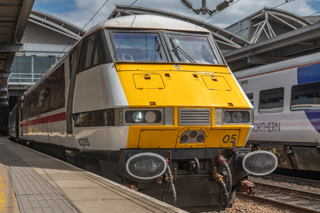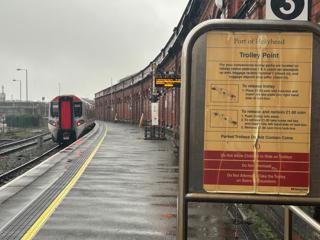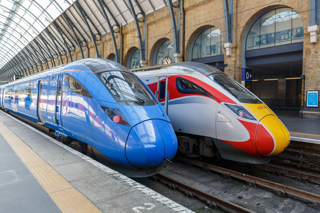- Read part 1, Neglected stations beyond the fringe (RAIL 777)
- View gallery of Gainsborough station photographs
Is the tide turning for Gainsborough?
From being a quiet town in the depths of Lincolnshire, seemingly condemned as an unloved and unwanted part of the railway, suddenly senior rail executives are planning to visit the town, but only after the plight of the local railway and its users was highlighted in RAIL 777. Unwanted investment that could have an adverse effect on the town is being challenged.
Transport Focus Chief Executive Anthony Smith is joining RAIL Managing Editor Nigel Harris next month, to see first hand the problems that the town faces.
The Friends of the Brigg Line have been campaigning relentlessly (but largely fruitlessly) regarding the plight of Gainsborough Central and Gainsborough Lea Road stations for many years. In the long term, they are thinking big… but for now they just want their pleas to be heard as they strive for very basic improvements.
Is this a situation where the regulated railway is failing its users? At Lea Road, Network Rail has spent around £250,000 on a point to a freight terminal that will probably never be used. And at Central it is determined to replace a steel lattice bridge with an identical structure that has no ramp access (at a cost of £350,000-£450,000), while at the same time removing a foot crossing. This means that disabled passengers, those wishing to cross platforms with heavy luggage, mums with buggies or those who are unsteady on their feet, will have to travel to Retford in order to catch a train heading east. That’s an added journey time of an hour.
The service provision at Gainsborough Central had dropped to one per day, through the cynical 1980s-style British Rail method of reducing the number of trains running and then claiming that no one used the trains. In 1993 the Monday to Saturday service was abolished, leaving trains to run on Saturdays only.
Yet there is clear evidence of demand. Local user groups report more than 150 passengers on one of the Saturday-only trains from Gainsborough Central. One of the Pacers that arrived on July 11 had just four seats spare, while 17 people boarded another train. That doesn’t sound a lot, but when there are only three trains per day, it illustrates that there is visible demand.
To Northern Rail’s credit, it increased the number of trains serving Gainsborough Central to three per day. But the current situation seems to be falling halfway between either developing the market or winding it down. And that benefits nobody.
This is the failure of the regulated railway at the fringes.
Major conurbations such as Manchester and Leeds demand constant investment, while London has received new trains. Yet in the flatlands of Lincolnshire, a town with two railway stations and a population of nearly 17,000 is being largely ignored. Is this a situation where the industry only cares about the main line?
Lea Road station enjoys regular services from Sheffield and Lincoln Central, while East Midlands Trains operates five trains (Monday to Saturday) between Doncaster and Lincoln Central (some extended to Peterborough).
But after several years of improving passenger numbers, Lea Road suffered a decline in 2013/2014, according to ORR station usage statistics. Last year 137,394 passengers used the station, down from 150,154 in 2012/2013. That was the first drop since 2008/2009, and the lowest passenger figures since 2009/2010, when 136,284 passengers used the station.
At Gainsborough Central the number of passengers increased in 2013/2014, with 1,220 using the station (up from 1,128 in 2012/2013). But it has yet to reach the 2009/2010 figure of 1,438, or even the 2011/2012 figure of 1,334.
Senior sources within the rail industry have cited the lack of signage at the station as a result of vandalism. Yet the local campaign group describes Gainsborough Central as “Britain’s most secure station”, because the neighbouring shopping complex has CCTV and the station gates are shut six days per week when the station is not open. Over at Lea Road, CCTV is also prevalent. Vandalism - the locals say - is rare.
Speaking to RAIL on July 13, the Friends of the Brigg Line’s Paul Johnson said that the previous week he had attended two meetings with Network Rail in York. Prior to that Johnson, a former career railwayman, had tried in vain for many years to meet the infrastructure owner. NR would never meet him.
“Incredibly, following on from the article in RAIL, I was invited to a forward planning session for Control Period 6 ,” he says, adding that representatives from local authorities and freight operating companies were also in attendance.
And he was pleased with the outcome: “It was positive. People were saying they want progression and economic growth.”
That sounds music to the ears of the campaigners, although there are still plenty of hurdles to overcome. Johnson explains: “Then I went on Friday . They confirmed they were not going to replace Brigg Bridge with a ramp, they said ‘this is what we are going to do’. Yet Brigg is a retirement town. Passengers are going to Barnetby to use that bridge. There would be a 25% increase at Brigg overnight if they put access in.”
Johnson says the project manager also claimed that the foot crossing at Gainsborough Central would be removed. This was challenged, but NR’s reply, he says, was that “each foot crossing has to be removed”.
Yet this flies in the face of work elsewhere. At Stamford station (managed by East Midlands Trains yet served mainly by CrossCountry), the once-closed foot crossing has been re-opened at the western end of the station.
Fenced off from the platforms, passengers must first ring the Ketton signaller, who will permit them to cross. When they have crossed the double-track railway, they must then ring the signaller again. It’s a simple system, but one that seemingly works. Seven days a week.
And what’s even more impressive here is that this has been installed on a blind bend, which means the appropriate risk assessments have been carried out. This therefore begs the question: if this system can be installed here, where heavy freight trains also thunder through at speed, why can’t Gainsborough benefit in a similar fashion with only three trains a day on Saturdays?
Johnson suggests that a resignalling scheme in 2017, whereby local signal boxes would be removed from service, would be the perfect time to install the new crossings (he argues this would also actually save money). He says he was told that the crossings have to be removed because people are being knocked over. “I’m trying to be patient,” he sighs.
However, Johnson praises local NR Stakeholder Manager Tim Wright, whom he says has promised a stakeholder meeting at Gainsborough Central.
No date has been set for this, but up for discussion will be the bridge. NR intends to replace this like for like at a cost of between £350,000 and £450,000, meaning that no ramp access will be installed.
The removal of the crossing means that passengers will first have to travel west to Retford if they want to head east. Retford is 12 miles away and takes 15 minutes by train. By car it takes anything from 35 to 45 minutes. Johnson estimates that a taxi costs about £30 each way. A single off-peak ticket is £4.70, and yet Northern Rail will be forced to pay six times that because no access will be provided from one platform to the other.
Johnson emphasises the absurdity of the situation by telling RAIL of his experiences on July 11: “There were 17 people who got on at Central, and seven of them had buggies.”
In the future, when the crossing closes, they must travel to Retford first. That could cost the train operating company as much as £210 if each buggy owner was in a separate taxi.
A subway exists that has been suggested for possible re-opening, but Johnson argues that the incline rules this out.
An extra train could help the station, he suggests. “If Northern can get a fourth train, we can get better productivity. There are two DMUs and two crews doing three trips. They can do an extra trip with the same staff and trains.”
Johnson praises Northern Rail Managing Director Alex Hynes: “I like Alex. He has been very proactive, and he says he will have a chat with the Network Rail Route Managing Director.
Hynes spoke to RAIL on July 13. He said: “Having seen the issues at first-hand, it is clear that the line’s potential can only be met through a joined-up approach. Northern will therefore be discussing the matter with NR at the earliest opportunity.”
While Northern’s response is praised, Johnson says that East Midlands Trains (which manages Gainsborough Lea Road) has “not talked to us since the article was published”. He praises EMT station staff at Lincoln for reporting feedback into the command chain at EMT, but says that the Friends have yet to hear from the train operator.
One obstacle to improved services is the fact that signal boxes on the line are only operated at certain times of the day. This means that passenger trains terminating at Retford cannot run on to Gainsborough Central (as the campaigners want), because signal boxes on the Brigg line are closed.
The ambition is for a DMU to run to Gainsborough Central, cross over, and return to Retford. Johnson says this would not take any additional time because the DMU is booked to sit at Retford for 45 minutes anyway. However, NR has reportedly told Northern that this would only be possible should the TOC fund a signaller’s wages for the duration of their time working to cover the train.
Yet elsewhere, Northern has to subsidise the use of a locomotive for Abellio Greater Anglia because of a lack of resources for AGA (owing to a contract with the Department for Transport taking trains away from Anglia for use on the Cumbrian Coast line).
ORR reports that since April 2014, seven complaints have been received (all from the Friends of the Brigg Line and none from members of the public).
The campaigners were seemingly fighting a losing battle, until RAIL 777 was published. Now Transport Focus Chief Executive Anthony Smith is planning a site visit, ORR Chief Executive Richard Price has agreed to discuss Gainsborough with the Friends of the Brigg & Lincoln Lines, while Northern Rail’s MD is willing to discuss the situation with his Network Rail route counterpart.
Let’s hope Gainsborough’s luck is about to change. Paul Johnson and the Friends deserve a break!
- This feature was published in RAIL 779 on July 22 2015.
- Read part 1, Neglected stations beyond the fringe (RAIL 777)
- View gallery of Gainsborough station photographs















Login to comment
Comments
No comments have been made yet.